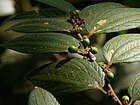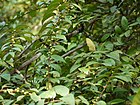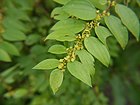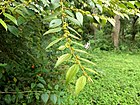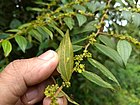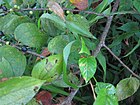Note: This is a project under development. The articles on this wiki are just being initiated and broadly incomplete. You can Help creating new pages.
Difference between revisions of "Ziziphus oenopolia"
(Created page with "{{stub}} ==Uses== {{Uses|}}, {{Uses|}}, {{Uses|}}, {{Uses|}}, {{Uses|}}, {{Uses|}}, {{Uses|}}, {{Uses|}}, {{Uses|}}, {{Uses|}}, {{Uses|}}.<ref name="Uses"/> ==Parts Used== {{...") |
|||
| Line 1: | Line 1: | ||
| − | + | [[File:Ziziphus oenoplia - Jackal Jujube at Mayyil (2).jpg|thumb|right]] | |
| + | '''Ziziphus oenopolia''' is a thorny, evergreen shrub with straggling branches, often scrambling into other vegetation; it can grow around 5 metres tall. The plant is harvested from the wild for local use as a food, medicine and source of materials. The fruits are sometims sold in local markets. The plant is sometimes grown as a hedge. | ||
==Uses== | ==Uses== | ||
| − | {{Uses|}}, {{Uses|}}, {{Uses|}}, {{Uses| | + | {{Uses|Cuts}}, {{Uses|Wounds}}, {{Uses|Indigestion}}, {{Uses|Stomachache}}.<ref name="Uses"/> |
==Parts Used== | ==Parts Used== | ||
| − | {{Parts Used|}}, {{Parts Used| | + | {{Parts Used|Root}}, {{Parts Used|Bark}}, {{Parts Used|Fruits}}. |
==Chemical Composition== | ==Chemical Composition== | ||
| − | <ref | + | It contains betulin, betulinic aldehyde, betulinic acid, alphitolic acid, euscaphic acid, zizyberenalic acid, and β−sitosterol, one coumarin, scopoletin and four flavonoids, kaempferol, afzelin, quercitrin etc.<ref nam="chemical composition"/> |
==Common names== | ==Common names== | ||
| − | {{Common names|sa=|en=|gu=|hi=|kn=|ks=|ml=|mr=|pa=|ta=|te=}} | + | {{Common names|sa=Karkandhauh|en=Jackal Jujube, Small-Fruited Jujube|gu=|hi=Makkay, Makai|kn=Pargi, Barige|ks=|ml=Tutali|mr=Burgi|pa=|ta=Suraimullu|te=Paraki}}<ref nam="Common names"/> |
==Properties== | ==Properties== | ||
| Line 16: | Line 17: | ||
===Dravya=== | ===Dravya=== | ||
===Rasa=== | ===Rasa=== | ||
| − | |||
===Guna=== | ===Guna=== | ||
| Line 29: | Line 29: | ||
==Habit== | ==Habit== | ||
| − | {{Habit|}} | + | {{Habit|Evergreen shrub}} |
==Identification== | ==Identification== | ||
| Line 48: | Line 48: | ||
==Mode of Propagation== | ==Mode of Propagation== | ||
| − | {{Propagation|}} | + | {{Propagation|Seeds}}, {{Propagation|Root suckers}}. |
==How to plant/cultivate== | ==How to plant/cultivate== | ||
| Line 54: | Line 54: | ||
==Commonly seen growing in areas== | ==Commonly seen growing in areas== | ||
| − | {{Commonly seen|}}, {{Commonly seen| | + | {{Commonly seen|Margins of subtropical forests}}, {{Commonly seen|Thickets}}. |
==Photo Gallery== | ==Photo Gallery== | ||
<gallery class="left" caption="" widths="140px" heights="140px"> | <gallery class="left" caption="" widths="140px" heights="140px"> | ||
| + | Aule Bayar (Nepalese- औले बयर्) (2991444173).jpg | ||
| + | |||
| + | |||
| + | Burgi (Konkani- बुर्गी) (4102831216).jpg | ||
| + | |||
| + | |||
| + | Burgi (Marathi- बुर्गी) (3969152169).jpg | ||
| + | |||
| + | |||
| + | Discolompa ethion,Banded blue pierrot, നീലവരയൻ ചെൻകോമാളി .jpg | ||
| + | |||
| + | |||
| + | Discolompa ethion,Banded blue pierrot, നീലവരയൻ ചെൻകോമാളി 2.jpg | ||
| + | |||
| + | |||
| + | Jackal Jujube - മുള്ളൻപ്പഴം 01.JPG | ||
| + | |||
| + | |||
| + | Jackal Jujube - മുള്ളൻപ്പഴം 02.JPG | ||
| + | |||
| + | |||
| + | Jackal Jujube - മുള്ളൻപ്പഴം 03.JPG | ||
| + | |||
| + | |||
| + | Jackal Jujube - മുള്ളൻപ്പഴം 04.JPG | ||
</gallery> | </gallery> | ||
| Line 64: | Line 89: | ||
<references> | <references> | ||
| − | <ref name="chemical composition">[ | + | <ref name="chemical composition">[https://www.researchgate.net/publication/271952479_Chemical_Constituents_of_the_Roots_of_Zizyphus_rugosa Chemical constituents]</ref> |
| − | <ref name="Leaf">[" | + | <ref name="Leaf">[Morphology]</ref> |
| + | <ref name="Common names">[http://www.flowersofindia.net/catalog/slides/Jackal%20Jujube.html#:~:text=Jackal%20Jujube%20is%20a%20very,nerves%20and%20numerous%20transverse%20nervules. Common names]</ref> | ||
| − | <ref name="How to plant/cultivate">[ | + | <ref name="How to plant/cultivate">[http://tropical.theferns.info/viewtropical.php?id=Ziziphus+oenopolia Cultivation]</ref> |
<ref name="Uses">Indian Medicinal Plants by C.P.Khare</ref> | <ref name="Uses">Indian Medicinal Plants by C.P.Khare</ref> | ||
</references> | </references> | ||
==External Links== | ==External Links== | ||
| − | * [ ] | + | * [https://indiabiodiversity.org/species/show/32385 Ziziphus oenoplia on indiabiodiversity.org] |
| − | * [ ] | + | * [https://sites.google.com/site/efloraofindia/species/m---z/r/rhamnaceae/ziziphus/ziziphus-oenoplia Ziziphus oenoplia on sites.google.com] |
| − | + | ||
[[Category:Herbs]] | [[Category:Herbs]] | ||
Revision as of 11:43, 10 September 2020
Ziziphus oenopolia is a thorny, evergreen shrub with straggling branches, often scrambling into other vegetation; it can grow around 5 metres tall. The plant is harvested from the wild for local use as a food, medicine and source of materials. The fruits are sometims sold in local markets. The plant is sometimes grown as a hedge.
Contents
- 1 Uses
- 2 Parts Used
- 3 Chemical Composition
- 4 Common names
- 5 Properties
- 6 Habit
- 7 Identification
- 8 List of Ayurvedic medicine in which the herb is used
- 9 Where to get the saplings
- 10 Mode of Propagation
- 11 How to plant/cultivate
- 12 Commonly seen growing in areas
- 13 Photo Gallery
- 14 References
- 15 External Links
Uses
Cuts, Wounds, Indigestion, Stomachache.[1]
Parts Used
Chemical Composition
It contains betulin, betulinic aldehyde, betulinic acid, alphitolic acid, euscaphic acid, zizyberenalic acid, and β−sitosterol, one coumarin, scopoletin and four flavonoids, kaempferol, afzelin, quercitrin etc.Cite error: Invalid <ref> tag;
invalid names, e.g. too many
Common names
| Language | Common name |
|---|---|
| Kannada | Pargi, Barige |
| Hindi | Makkay, Makai |
| Malayalam | Tutali |
| Tamil | Suraimullu |
| Telugu | Paraki |
| Marathi | Burgi |
| Gujarathi | |
| Punjabi | |
| Kashmiri | |
| Sanskrit | Karkandhauh |
| English | Jackal Jujube, Small-Fruited Jujube |
Cite error: Invalid <ref> tag;
invalid names, e.g. too many
Properties
Reference: Dravya - Substance, Rasa - Taste, Guna - Qualities, Veerya - Potency, Vipaka - Post-digesion effect, Karma - Pharmacological activity, Prabhava - Therepeutics.
Dravya
Rasa
Guna
Veerya
Vipaka
Karma
Prabhava
Habit
Identification
Leaf
| Kind | Shape | Feature |
|---|---|---|
Flower
| Type | Size | Color and composition | Stamen | More information |
|---|---|---|---|---|
| {{{5}}} |
Fruit
| Type | Size | Mass | Appearance | Seeds | More information |
|---|---|---|---|---|---|
Other features
List of Ayurvedic medicine in which the herb is used
Where to get the saplings
Mode of Propagation
How to plant/cultivate
Commonly seen growing in areas
Margins of subtropical forests, Thickets.
Photo Gallery
References
- ↑ Indian Medicinal Plants by C.P.Khare
- ↑ [Morphology]
- ↑ Cultivation
Cite error: <ref> tag with name "chemical composition" defined in <references> is not used in prior text.
Cite error: <ref> tag with name "Common names" defined in <references> is not used in prior text.
External Links
- Pages with reference errors
- Ayurvedic Herbs known to be helpful to treat Cuts
- Ayurvedic Herbs known to be helpful to treat Wounds
- Ayurvedic Herbs known to be helpful to treat Indigestion
- Ayurvedic Herbs known to be helpful to treat Stomachache
- Herbs with Root used in medicine
- Herbs with Bark used in medicine
- Herbs with Fruits used in medicine
- Herbs with common name in Kannada
- Herbs with common name in Hindi
- Herbs with common name in Malayalam
- Herbs with common name in Tamil
- Herbs with common name in Telugu
- Herbs with common name in Marathi
- Herbs with common name in Sanskrit
- Herbs with common name in English
- Habit - Evergreen shrub
- Index of Plants which can be propagated by Seeds
- Index of Plants which can be propagated by Root suckers
- Herbs that are commonly seen in the region of Margins of subtropical forests
- Herbs that are commonly seen in the region of Thickets
- Herbs

